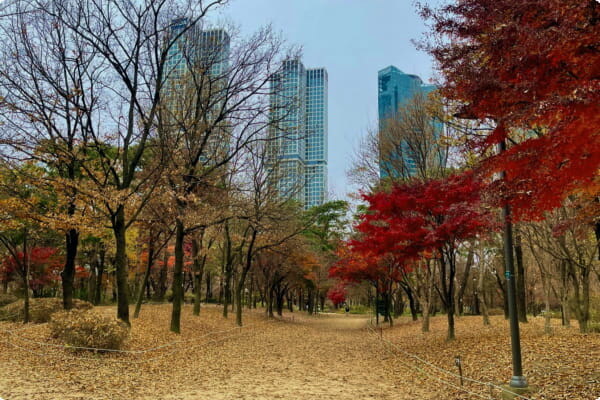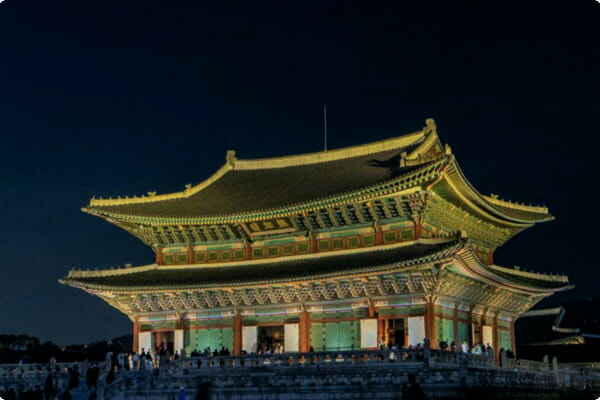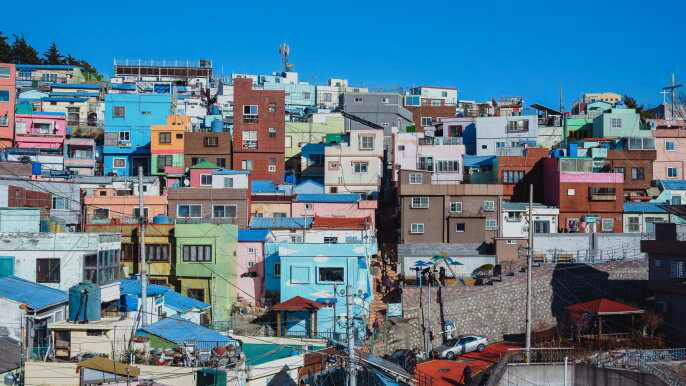During your visit to South Korea, you will have plenty of opportunities to experience the country's beautiful landscapes. From lush green countryside to ancient Buddhist temples, you'll be surrounded by a variety of natural attractions that will keep you coming back for more.
Seoul Forest
Located in Seongdong-gu, Seoul, the Seoul Forest is a green oasis in the heart of Seoul. It's a popular tourist attraction and has been the site of numerous arts and cultural events. It's also a great place to go to watch the cherry blossoms in the spring and the fall foliage.
Seoul Forest is divided into four sections. The first section is the Culture and Art Park, which features an outdoor theater, a playground, and a variety of sculptures. Another section is the Eco-Friendly Forest, which allows visitors to interact with deer.

The Nature Study Field is a botanical garden. There are also several walking/running paths. There is also a Natural Experience Site, which teaches about the history of the park. There are also greenhouses filled with butterflies and deer to feed.
Another section of the park is the Culture & Art Park, which includes a waterfront marina. It also has a giant greenhouse and several outdoor stage performances. It's a great place to take the kids.
Another popular attraction in the park is the Experiential Learning Park. There are several interactive displays, including a natural experience site, a botanical garden, and a chipmunk exhibit. There is also a playground for children.
A third section of the park is the Marsh Plants Garden. It has an impressive collection of plants, including hibiscus, daffodils, and tulips.
The best time to visit the park is in the early morning or the evening. You can find a bicycle rental shop outside the entrance. A day of bicycle rental costs about 10,000 won.
Gyeonbokgung Palace
Located in Seoul, Gyeongbokgung Palace is one of the city's most popular tourist attractions. During the Joseon Dynasty, Gyeongbokgung Palace served as the royal home of the king and the political seat of the country. Gyeongbokgung Palace is a historical site of great significance, and it has survived many wars. The palace is now a museum that showcases the history of Korea.
The palace is located on 101 acres of land. The buildings are restored with incredible attention to historical accuracy. The palace includes a number of pavilions and ponds. These pavilions include the Gyeonghoeru Pavilion, the Gyeonghoeru Pavilion, and the Hyangwonjeong Pavilion. The pavilions were built to serve as a place for formal dinners, celebrations, and leisure.

The Gyeonghoeru Pavilion is the largest pavilion in Korea. It sits on a tranquil pond. It also features views of Mount Ingwangsan. The pavilion is divided into twelve rooms.
The palace also offers free guided tours. These tours begin at the information center in front of the palace. They last for approximately one and a half hours. They are available in both Korean and English.
The palace grounds are filled with ponds, flower gardens, and statues. Visitors can also try on traditional Korean clothing. In addition to the palace, visitors can visit the National Palace Museum of Korea and the National Folk Museum of Korea.
The palace is also open to the public at night. Visitors can take advantage of the Starlight Tour program, which takes place twice a day. These tours include a traditional Korean music Gugak performance and an explanation of the history and architecture of the palace.
Gwanghwamun Gate
Located in Seoul, Gwanghwamun is a famous tourist attraction. It is the main gate of Gyeongbokgung Palace, which was built during the Joseon Dynasty. The gate is surrounded by a statue of King Sejong the Great. The statue represents the man who invented the Korean alphabet, Hangeul, in the early-1400s.
Gyeongbokgung Palace is a large building that was built in the late Joseon Dynasty. The palace is filled with ornate statues, lotus ponds and gardens. It also serves as the home to the National Folk Museum of Korea.
The changing of the guards ceremony is a tradition that has been practiced since the Joseon Dynasty. Guards in red robes will perform the ceremony. It takes place daily from 10:00 to 15:00. It is free to watch.
Gwanghwamun Gate was first built in 1395. During the Korean War, the gate was destroyed and later rebuilt. In 1968, the stone base of the gate was relocated to the Japanese Governor General Building.
Until late 2006, the gate was only a concrete structure. It was later restored to its original condition. In August 2010, it was fully restored. The gate has three arched gateways and a traditional two-story pavilion. Its pillars are decorated with native materials.
The square surrounding the gate is filled with statues, fountains, and sculptures. There is also an underground museum dedicated to King Sejong the Great. The square is also home to a variety of public gatherings and political demonstrations. It is also the site of a major art installation.
Uleung Island Seaside Road
Located on the eastern coast of Korea, Ulleungdo is the home of a few rocks and is one of the best seaside destinations in South Korea. The island boasts some of the most beautiful views of Korea's natural beauty. The island is also known for its rich marine life.
Ulleungdo is known for its beaches, but you can get around the island on foot or by scooter. Hakpo Beach is one of the best beaches on the island and offers great snorkeling. You can also enjoy kayaking.
Ulleung Island is surrounded by emerald blue seas and rocky shorelines. It is also home to a number of festivals and activities. Some of the most popular are the Ulleung Seaside Song Festival and the Mountain Ski Festival. These festivals are held in various parts of the island.
Ulleungdo Island is a great place to spend a holiday if you are looking for a quiet place to relax. The island is also known for its rich culture and traditions. The island has been inhabited since the 1st millennium BC. In the 1880s, the Korean government began a resettlement plan for Ulleungdo.
Ulleungdo is also known for its stunning sea walkways. These walkways follow volcanic cliffs around the ocean edge. This is the only flat area on the island and is a beautiful way to view the island's landscape. You can also visit pop-up restaurants on the island.
Cheongsando island
Located off the south coast of Korea, Cheongsando Island is known for its scenic landscapes. It is the main island of Cheongsan-myeon, one of the provinces of South Jeolla. In fact, Cheongsando is a very popular island with many attractions to offer.
The island is famous for its terraced rice paddies. These are considered a globally important agricultural heritage system. In Korea, the name for these rice fields is called gudeuljang non.
Another attraction is the Bukchon Hanok Village, where you can explore traditional Korean homes and tea houses. It is also home to cultural centers and traditional restaurants. The village dates back to the Joseon Dynasty and the streets are narrow and winding.
Another place to visit is the Upo Wetland, which is home to nearly 1500 plant species and 1500 animals. The marsh is also home to migratory birds. In fact, some of the animals on the island are endangered.
The island is also home to many hiking trails. In fact, the path on Cheongsando is called the Slow Path. The path is a series of 11 paths, combining to form a distance of 42.2 kilometers. The paths encourage walkers to slow down and enjoy the beautiful scenery.
The island also offers a Slow Walking Festival every spring. This festival is a great way to explore the island's natural beauty.
The island is also home to Sansuyu Village, which is known as the village of tranquility. The village is made up of terraced rice paddies and the walls of the houses are built of naturally formed stones. In the fall, the trees are adorned with red berries. In the spring, the trees turn yellow.
Halla Mountain
Located on a small 74 km island, Halla Mountain is a dormant volcano. The island has a variety of animals, plants, and subspecies. These include tropical animals, polar animals, and various bird species.
The mountain is also home to a crater lake named Baengnokdam. This lake is located inside the crater of the volcano at its peak. The lake is formed after the last Hallasan eruption. It is estimated that the depth of the lake is up to 100 meters.
There are several hiking trails at Halla Mountain. Some of them are shorter and are less difficult. If you're only hiking for a day, you can take shorter routes that take less than an hour. However, if you want to see the most attractions on the island, you'll have to take longer routes.
The longer routes can take 8 to 9 hours to reach the summit. This is why you should start early. You'll have a much better chance of seeing all the attractions if you start early.
Halla Mountain is located in Jeju island, South Korea. You can take buses to the trailhead from the Jedae Village. Some routes close after lunch, so it's important to plan your hike carefully.
Halla National Park is one of the most popular places to visit on Jeju island. The park features abundant black lava stone-scapes. It also features sweet tangerines.
Hallasan is also home to a number of animals, including roe deer, white-backed woodpeckers, and badgers. In addition, there are 19 bird species protected by the government.





